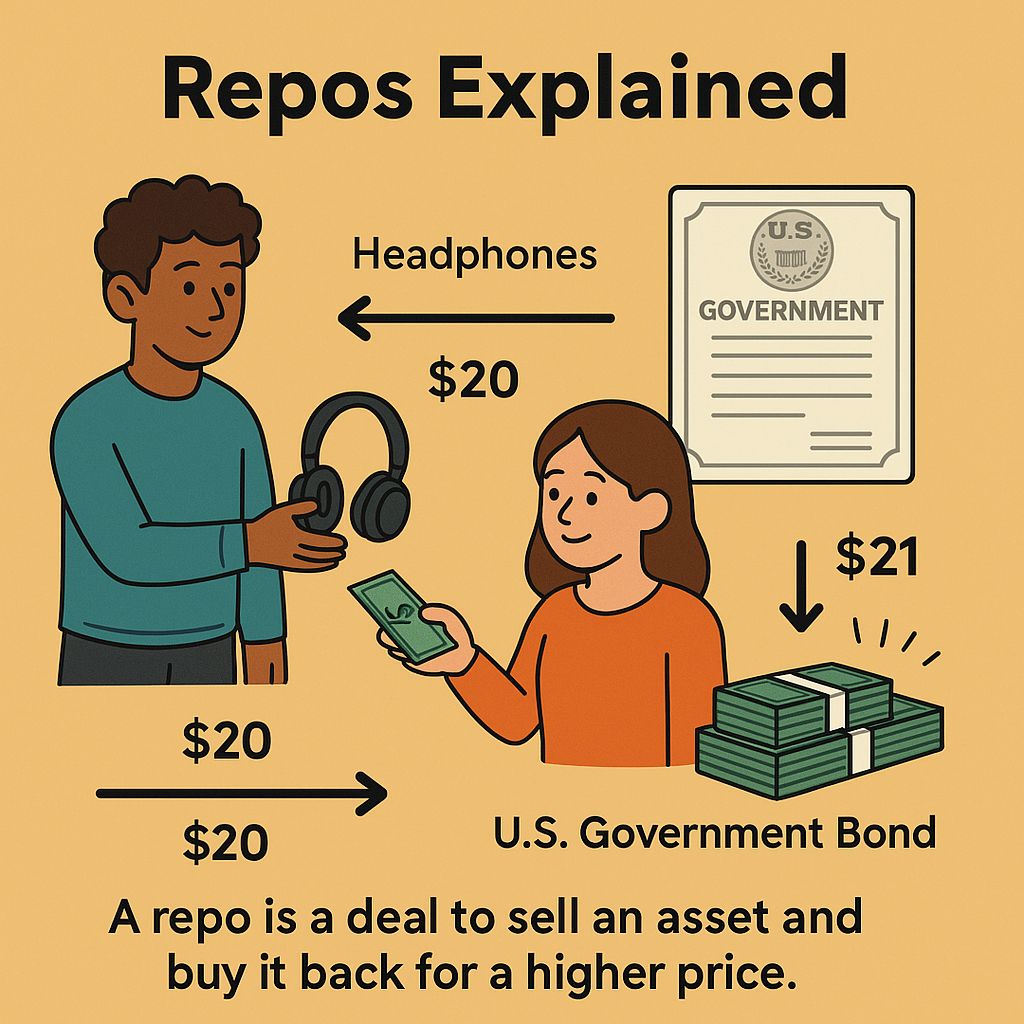How Banks Borrow Money (Just Like You Might!)
Have you ever borrowed money from a friend and promised to pay them back the next day—with a little extra, just to say thanks? Congratulations—you already understand the basic idea behind repos!
In the financial world, “repo” is short for repurchase agreement. It’s a fancy term, but don’t worry—we’ll break it down in a way that actually makes sense.
So, What’s a Repo?
A repo is a deal between two parties, usually big financial companies or banks. One party sells a valuable item (like a U.S. government bond) to the other, but promises to buy it back very soon—sometimes the next day—for a slightly higher price.
That “extra” is basically the interest, or the cost of borrowing the money.

Real-Life Comparison
Let’s say you need $20 today, but you don’t get your allowance until tomorrow. So, you give your friend your headphones as “collateral” and promise to buy them back tomorrow for $21. Your friend holds onto the headphones just in case you don’t come back with the money.
This is almost exactly how a repo works—except instead of headphones, it’s usually a government bond, and instead of $20, it might be millions of dollars.
Why Do Banks Use Repos?
Banks and financial companies don’t just deal with money—they often hold a lot of their value in the form of bonds or other assets. But sometimes they need actual cash quickly—like overnight—to handle business or meet regulations.
Repos help them:
- Borrow money fast without selling off assets permanently
- Make sure they have enough cash to operate smoothly
- Avoid more expensive or risky types of loans
And for the lender, repos are a way to earn a little money with very low risk.
What About the Federal Reserve?
The Federal Reserve (the U.S. central bank) uses repos too. When it wants to add more money to the economy, it offers to buy bonds through repos. This puts cash into the banking system and helps lower interest rates.
When the Fed wants to do the opposite—pull some money out to cool down inflation—it uses reverse repos, where it takes in cash and gives out bonds temporarily.
What Happened During the 2008 Financial Crash?
In 2008, the financial system was in big trouble. Banks and investment firms had loaded up on risky assets like mortgage-backed securities—basically bundles of home loans, many of which were failing. When those assets started to lose value, people in the repo market got nervous. Lenders no longer trusted the collateral being offered and stopped making repo loans. This caused a major liquidity crisis, where banks couldn’t get the short-term cash they needed to keep running. Some even collapsed. The repo market, which usually runs quietly in the background, suddenly became one of the key reasons the financial system nearly froze.
Why Should You Care?
Even though repos happen behind the scenes, they play a big role in how the economy works. They help:
- Keep interest rates steady
- Make sure banks have enough cash
- Prevent financial stress or panic
When something goes wrong in the repo market, it can affect things like student loans, mortgages, credit cards, and even job opportunities—because the entire economy feels the impact.
Final Thoughts
Repos might sound complex at first, but they’re really just short-term loans with a promise to buy something back. Think of them like a fast and safe way for banks to borrow money, just like you might borrow a few bucks from a friend.
They may be behind the scenes, but they keep the financial system running smoothly—and now you know how they work.
